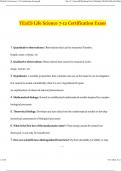TExES Life Science 7-12 Certification Exam.pdf file:///C:/Users/HP/Desktop/New%20folder/TExES%20Life%20Scie
TExES Life Science 7-12 Certification Exam
1. Quantitative observations: Observations that can be measured Number,
length, mass, volume, etc
2. Qualitative observations: Observations that cannot be measured Color,
shape, texture, etc
3. Hypothesis: A testable proposition that scientists can use as the basis for an investigation
If it cannot be tested scientifically, then it is not a hypothesis Propose
an explaination of observed natural phenomenon
4. Mathematical biology: Rooted in multifaceted mathematical models inspired by complex
biological processes
5. Theoretical biology: Develops and uses data from the mathematical models to develop
theoretical assessments of biological processes
6. What is the first law of thermodynamics state?: That energy cannot be created nor
destroyed, it can only be transferred
7. How are scientific laws distinguished from facts?: By their durability (or ability to stay
1 of 48 9/13/2024, 5:12
,TExES Life Science 7-12 Certification Exam.pdf file:///C:/Users/HP/Desktop/New%20folder/TExES%20Life%20Scie
constant over time)
Facts are the observations themselves, they are never considered final proof Scientific laws are a
generalized description of natural phenomena over time based on multiple observations
8. Cell theory: States that all living things are made up of cells Cells can
only come from other cells
Robert Hooke used a microscope to identify, describe, and name cells
9. Germ theory: Microorganisms, "germs", were found everywhere and contributed to both
food spoilage and disease
Work of Louis Pasteur
Confirmed the cell theory that cells only come from other cells
10. What are the driving forces of evolution?: Descent with modification and natural
selection
Work of Charles Darwin
11. Structure of genetic material:: Hershey and Chase - initially confirmed that DNA
comprises the genetic material of cells
Watson and Crick - revealed that the structure of DNA is a double helix (based off the work of
Franklin)
12. Carl Linnaeus: Developed the hierarchal system
2 of 48 9/13/2024, 5:12
,TExES Life Science 7-12 Certification Exam.pdf file:///C:/Users/HP/Desktop/New%20folder/TExES%20Life%20Scie
Grouped species into seven levels (kingdom, phylum, class, order, family, genus, and species)
13. Carl Woese: Modified Linnaeus' hierarchal system
Redrew the taxonomic tree, added "domain" to the top of the classification system
3 of 48 9/13/2024, 5:12
,TExES Life Science 7-12 Certification Exam.pdf file:///C:/Users/HP/Desktop/New%20folder/TExES%20Life%20Scie
14. Precision: Refers to how close repeated values are to one another (On a
target, all the holes are right next to each other)
15. Accuracy: Refers to how close a measured value is to the true value (On a target,
all of the holes are within the same ring)
16. What are the seven SI units?: Meter, kilogram, second, ampere, kelvin, can- dela, and
mole
17. What are significant figures?: The non zero numbers, the zeros between them, and
the final zero
18. Linear scale: Shows equal values using equal divisions Waves or
mechanical motion
19. Logarithmic scale: Nonlinear , units are written in powers of 10 Richter
scale, entropy, and the decibel unit used to measure sound
20. Crucibles: When heating things at very high temperatures, this is the best thing to use
because they are resistant to the high temperatures
21. What composes the nucleus of an atom?: Protons - positively charged Neutrons -
neutrally charged
22. Electrons: Negatively charged particles within the electron cloud surrounding the nucleus
4 of 48 9/13/2024, 5:12




